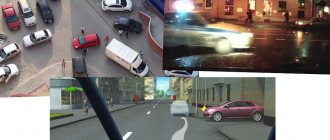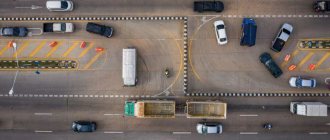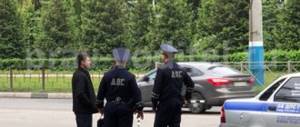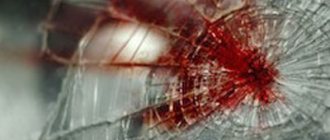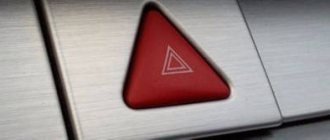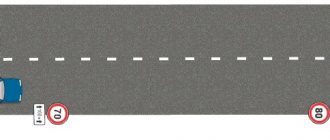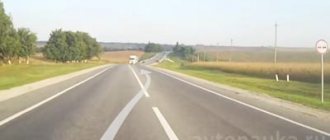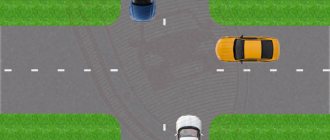Good afternoon, dear reader.
Driving on the side of the road is one of the most common violations that motorists have to deal with.
This article will discuss the rules for driving on the side of the road, as well as the fines that can be imposed for violating these rules:
- What is a curb?
- Who can drive on the side of the road? pedestrians;
- cyclists;
- moped drivers;
- horse-drawn carts.
- to stop;
What is a curb?
The concept of a shoulder is discussed in paragraph 1.2 of the traffic rules:
“Shoulder” is an element of the road adjacent directly to the roadway at the same level with it, differing in the type of surface or marked out using markings 1.2, used for driving, stopping and parking in accordance with the Rules.
There are 2 options for organizing the curb:
- No markings . In this case, the roadside differs in the type of coating (for example, it is covered with crushed stone).
- With markings . In this case, the coating does not matter, that is, the roadside can be asphalt, crushed stone, or dirt.
Two shoulder options are shown in the following figure:
You also need to remember that the shoulder is part of the road:
“Road” is a strip of land or a surface of an artificial structure equipped or adapted and used for the movement of vehicles. The road includes one or more carriageways, as well as tram tracks, sidewalks, shoulders and dividing strips, if any.
What is the fine for driving on the side of the road in 2021?
The amount of sanctions depends on the specific situation. Penalties for violations are described in Art. 12.15 Code of Administrative Offenses of the Russian Federation.
| Type of offense | Amount of sanctions | Peculiarities |
| Driving on the side of the road located in the driver's lane (on the right side). | 1500 rub. | This act is interpreted as a violation of the rules of maneuvering. |
| Pass on the side of the road on the left (overtaking). | Driving ban for up to 6 months or a fine of 5 thousand rubles. | If the driver is convicted a second time, the period of deprivation of license increases to 1 year. |
| Driving on the sidewalk or lawn. | 2000 rubles. | It is considered a violation to drive even one wheel over the curb. |
In addition to the fine for going to the side of the road, a number of other sanctions may be added for offenses that arose as a result of crossing the markings:
- 500 rubles for ignoring a sign or road markings;
- A driver can receive 2.5 thousand rubles for driving along the side of the road if this action interferes with pedestrians;
- From 2 to 2.5 thousand rubles - a fine for driving on the side of the road, resulting in harm to the health of a road user.
It should be understood that driving on the right or on the opposite side of the road can create dangerous situations on the road: an increased risk of accidents, dust on the road, traffic jams, and the creation of obstacles for pedestrians.
Who can drive on the side of the road?
Let's consider the points of the traffic rules that allow driving on the side of the road.
Pedestrians
Paragraph 4.1 of the traffic rules:
4.1. Pedestrians must move on sidewalks, pedestrian paths, bicycle and pedestrian paths, and, if there are none, along the roadsides.
Pedestrians can walk along the side of the road if there is no sidewalk, pedestrian or bicycle path on the road.
Cyclists
Paragraph 24.2 of the traffic rules:
24.2. Cyclists over the age of 14 are allowed to travel: ... along the side of the road - if there are no bicycle and bicycle pedestrian paths, a lane for cyclists, or there is no opportunity to move along them or along the right edge of the roadway;
Cyclists can ride on the side of the road only if there is no bicycle or pedestrian path or lane for cyclists on the road, or if it is impossible to move along them and along the edge of the roadway.
Moped drivers
Paragraph 24.7 of the traffic rules:
24.7. Moped drivers are allowed to move along the side of the road if this does not interfere with pedestrians.
Moped drivers may ride on the side of the road regardless of the presence of other road elements, but they must not interfere with pedestrians.
Horse-drawn carts
25.2. Horse-drawn carts (sleighs), riding and pack animals must move only in one row, as far to the right as possible. Driving on the side of the road is allowed if this does not interfere with pedestrians.
Horse-drawn vehicles and animals have the right to move along the roadsides without interfering with pedestrians.
So, is the shoulder part of the road or a carriageway?
As a result, it must be said that the shoulder is a natural part of the road. And clause 12.1 of the traffic rules allows you to use it for parking or stopping. Also, according to clause 8.8, it can be used for turning, according to clause 24.2 - for bicycles or mopeds. And according to clause 4.1, pedestrians are allowed to walk on it. However, it is not and cannot be a roadway. After all, it does not belong to those areas where vehicles can drive. And in general, it cannot be considered a mandatory element.
Complain
Are cars allowed on the side of the road?
First of all, let’s turn to clause 9.9 of the traffic rules:
9.9. The movement of vehicles on dividing strips and shoulders, sidewalks and pedestrian paths is prohibited (except for the cases provided for in paragraphs 12.1, 24.2 - 24.4, 24.7, 25.2 of the Rules), as well as the movement of motor vehicles (except mopeds) on lanes for cyclists. The movement of motor vehicles on bicycle and bicycle-pedestrian paths is prohibited. The movement of vehicles of road maintenance and utility services is allowed, as well as access along the shortest route for vehicles delivering cargo to trade and other enterprises and facilities located directly next to the roadsides, sidewalks or pedestrian paths, in the absence of other access options. At the same time, traffic safety must be ensured.
So, from this point we can draw the following conclusions:
- In most cases, driving on the roadside is prohibited .
- There are a few exceptions discussed elsewhere in the rules. Some of these points were given earlier in this article (for cyclists, mopeds and horse-drawn vehicles), some will be discussed below.
- Vehicles of public utilities and road maintenance services can drive along the roadsides, i.e. vehicles engaged in road maintenance and cleaning.
- Cars can drive along the roadsides, delivering cargo to objects located directly next to the roadsides.
As for ordinary passenger cars, in most cases they do not fall into the above list, that is, they cannot drive on the side of the road.
Pulling to the side of the road to stop
Let's consider clause 12.1 of the traffic rules:
12.1. Stopping and parking of vehicles is permitted on the right side of the road on the side of the road, and in its absence - on the roadway at its edge and in the cases established by paragraph 12.2 of the Rules - on the sidewalk.
The car can pull to the side of the road to stop. At the same time, he can cross the solid marking line that separates the side of the road:
1.2 - indicates the edge of the roadway;
Line 1.2 is allowed to be crossed to stop a vehicle on the side of the road and when leaving it in places where stopping or parking is permitted.
That is, you can stop both on the side of the road without markings and on the side with markings:
Pulling to the side of the road when making a U-turn
Let's consider clause 8.8 of the traffic rules:
If, when turning outside an intersection, the width of the roadway is not sufficient to perform the maneuver from the extreme left position, it is allowed to be made from the right edge of the roadway (from the right shoulder). In this case, the driver must give way to passing and oncoming vehicles.
So, when turning outside an intersection, the driver can start the maneuver from the side of the road if the width of the roadway is not enough for him:
Please note that the rules do not allow crossing the solid markings separating the side of the road when making a U-turn. That is, if the side of the road is marked only structurally (by another coating), then you can start turning around from there. If it is separated by markings, then you cannot drive onto it when you start to turn.
When can you go to the side of the road?
All drivers know that driving on the side of the road is prohibited. This is specified in Article 12.15 of the Code of Administrative Offenses of the Russian Federation, which determines the rules for positioning a car on the roadway, passing oncoming traffic or overtaking.
Paragraph 1 of this article states that the movement of a car on the side of the road, recorded either by cameras or by traffic police officers, entails an administrative fine of 1,500 rubles.
Are there any exceptions to this rule and when can you legally drive to the side of the road?
To begin with, let’s define what is generally called the curb, what is meant by this concept. According to the terms of the traffic rules, the shoulder is an element of the road that is directly adjacent to the roadway, is on the same level with it and is used for the movement, stopping and parking of vehicles. It is emphasized that the shoulder is marked either with a coating that differs from the nature of the roadway surface (for example, a dirt shoulder), or with the help of special markings.
And although the traffic rules (clause 9.9) in most cases prohibit cars from driving on the side of the road, there are still several exceptions when such movement is permitted. For example, vehicles of municipal and road maintenance services, which are used for cleaning and road maintenance, can freely travel along the roadsides. Also, the “curbside rule” does not apply to vehicles that deliver cargo to objects located near the roadside.
The driver of a passenger car can drive onto the side of the road and drive along it if he is forced to go around the scene of an accident. Such actions are considered committed under conditions of extreme necessity, and, according to Article 2.7 of the Code of Administrative Offences, no punishment is provided for them.
And traffic rules do not prohibit the driver of a passenger car from pulling to the side of the road to stop. Thus, paragraph 12.1 of the traffic rules states that stopping and parking a car is permitted on the right side of the road on the side of the road. In this case, we are talking about both the side of the road with and without markings.
You can also drive onto the right side of the road to make a U-turn. The main thing is not to forget that this is allowed outside the intersection and only in the place where the side of the road differs in the type of surface from the main road. The rules stipulate that if there is not enough width of the roadway to carry out such a maneuver, the driver has the right to start turning from the side of the road. However, when starting such a maneuver, he must give way to cars of passing and oncoming traffic.
Do not forget that when driving onto the side of the road in a place where the road markings have become worn and erased, the driver runs the risk of getting a fine. After all, both the width of the roadway and the width of the shoulder are determined by GOST, so the formal absence of markings most often leaves a reason to impose a penalty on the violator. In addition, driving on the side of the road is one of the most unsafe maneuvers. When driving along the side of the road in a traffic jam, a car driver puts himself and other road users at risk.
Is it possible to stand on the side of the road?
The accident happened on January 1, after turning, I was blinded by an oncoming car, going to the right and hitting a pole.
On the night of January 1, I was returning home at about 4.00 am. After turning left in the city of Seltso, I was blinded by a car that was almost in the oncoming lane, I took a right to the side of the road to avoid a collision. After the car passed, I felt a strong blow and lost consciousness. It turned out I hit an electric pole (it leaned a little). After an indefinite period of time, someone started pushing me and asked whether I was alive or not. He asked if there were any more victims, to which I answered no. He suggested going to the hospital because there was blood coming from my head, eyebrow and temple area, and I was feeling sick and practically couldn’t stand. To which I refused and asked to be taken home, because after that I would come and resolve issues with the car. After that, a driver I didn’t know advised me to unscrew the license plates so that, as he said, they wouldn’t steal it until I arrived. He helped me unscrew it because I was unable to, and took me to the village. I don’t know who this driver was, he didn’t leave coordinates, but I couldn’t remember because I felt very bad, my head hurt badly, and I kept a rag to my face the whole way so that the blood wouldn’t flow. I was at home, my condition was very bad, I could not look at the light, and therefore I sat on the sofa, covering my face with my hands. I don’t remember, perhaps I fell asleep a little in this state. In the afternoon, police officers arrived and said that I had left the scene of the accident. When my wife and I arrived at the scene of the accident, my car was opened, the documents were lying on the seat (unfortunately, the photos were missing, I’m unlikely to be able to prove that it was there now...). They started processing and suggested that I go to the hospital, to which I replied that I would not go anywhere, since I needed, first of all, to pick up the car. The traffic police officers said that you need to sign the documents, then you will take the car. I signed where they told me to, because I had a severe headache and I wanted to finish it all quickly. In my explanation, I wrote that, not understanding what was happening, I went home in a state of passion. However, take the car to a fine. Parking lot, and then they told me that I refused the media. The next day, instead of a medical institution, I had to go to the traffic police to get a certificate, then go to a private parking lot. There I found out that I need to pay 9,600 rubles for a tow truck, and 650 rubles. for storage. At the same time, they didn’t give me the check, explaining that they didn’t have it now, they’ll give it back later... I can change something, because now I realized that I was nicely treated, that I signed my own death sentence. .. Is it possible to at least change something...
Rules for stopping on the side of the road
Traffic regulations provide for stopping a vehicle on the highway in places where special “Parking” or “Rest Place” signs are installed. A forced stop, including on the side of the road, in the event of an unforeseen situation is regulated by clause 16.2 of the Traffic Regulations of the Russian Federation: the driver of the car is obliged to immediately turn on the emergency lights and put up an emergency stop sign.
In addition, in order not to endanger other road users, it would be a good idea to additionally mark the car (especially at night) with a fog alarm, the lights of which are brighter and more visible from afar.
If such a situation occurs in a place where stopping a vehicle is prohibited, the motorist must take measures to leave this area as soon as possible.
Forced to stop on the side of the road? In such a case, take the necessary precautions. By strictly following traffic rules, you are guaranteed to avoid fines and protect your life.
